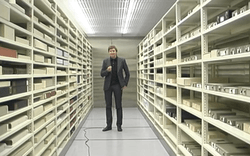Glimpses of Nuclear Ontario
Photographs by Robert Del Tredici. Texts by Robert Del Tredici and Gordon Edwards
Eighteen thousand people live in picturesque Port Hope on the north shore of Lake Ontario, an hour’s drive from Toronto. The town is host to one of the oldest and largest uranium chemical processing facilities on the planet, located not far from the downtown shopping district. In the background of the image above are the two key uranium conversion facilities: the smaller structure, on the left, processes uranium for domestic use; the larger building, on the right, processes uranium for exports worldwide.
The Cameco Uranium Conversion Plant began its life in 1932 as a radium refinery. In 1942 it started refining uranium for the Manhattan Project. During these years, the refinery dumped radioactive waste directly into the adjacent harbour, where the Port Hope Yacht Club still moors its leisure craft. Uranium continued to be processed at Port Hope for the US nuclear weapons program until 1965.
Uranium mined in Saskatchewan is first processed in northern Ontario’s Blind River refinery, where it is turned into uranium trioxide gel. The gel is then shipped to Port Hope, where it is chemically converted into other uranium compounds. Uranium dioxide (15 percent of Cameco’s output) is produced in the building on the left; it is later fabricated into fuel rods for domestic use. In the larger building on the right, uranium hexafluoride (85 percent of Cameco’s output) is produced for export. The hexafluoride is shipped to enrichment plants that produce low-enriched uranium (LEU) for fuel in light-water reactors throughout the world, and highly enriched uranium (HEU) that can be used for nuclear submarine fuel, medical isotope production, and nuclear weapons.
St. Mary’s Elementary School had to be evacuated in 1975 when radioactive radon gas was detected inside. Radon levels in the cafeteria were higher than the limits allowed in an underground uranium mine. This was because the radioactive gas was being continually generated by radium-bearing sandy wastes that had been used as fill in the school playground and around the school’s foundations. The local uranium refinery had made these radioactive materials freely available to Port Hope’s citizens in the late 1950s.
In 1975, the contaminated material around St. Mary’s School was excavated and trucked to a local radioactive dump. Today, one of the most expensive municipal environmental cleanups in Canadian history is underway in Port Hope as radioactive wastes have been identified at hundreds of properties and in local ravines. Over one million cubic metres of material have been located so far. The wastes will be collected, repackaged, transported, and stored in an engineered long-term facility just north of the town, in the village of Welcome. The project also calls for dredging the harbour to recover much of its radioactive sediment. This cleanup is a joint venture between the Canadian federal government and the town of Port Hope, at the estimated cost of $1.2 billion.
Read more





















